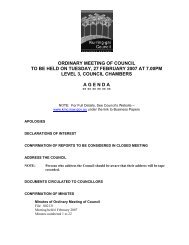Pymble Business Park - Ku-ring-gai Council
Pymble Business Park - Ku-ring-gai Council
Pymble Business Park - Ku-ring-gai Council
Create successful ePaper yourself
Turn your PDF publications into a flip-book with our unique Google optimized e-Paper software.
7.1 PEDESTRIAN ACCESS/EQUITABLE<br />
ACCESS<br />
7<br />
Objectives<br />
Controls<br />
1 To encourage<br />
consideration of access<br />
issues at the start of<br />
the development design<br />
process.<br />
2 To ensure convenient,<br />
safe and legible access for<br />
all people throughout the<br />
pedestrian network and<br />
public open space.<br />
3 To ensure that buildings<br />
used by the public have<br />
safe and convenient<br />
access for all.<br />
4 To ensure that substantial<br />
building refurbishment, or<br />
intensified use of existing<br />
buildings, provides<br />
upgraded levels of access<br />
and facilities for all people.<br />
5 To ensure that people<br />
with a disability have<br />
equal access to work by<br />
providing inclusive access<br />
to facilities, services and<br />
opportunities to meet their<br />
specific needs.<br />
1 Applications for development, other than single dwellings, are to<br />
demonstrate how access to and within developments meets the<br />
requirements of the Disability Discrimination Act 1992 (DDA).<br />
Note: Section 23 of the Disability Discrimination Act 1992 (DDA) requires nondiscriminatory<br />
access to premises which the public or a section of the public is<br />
entitled or allowed to use.<br />
Some of the premises covered by section 23 include:<br />
• Public footpaths, walkways, pedestrian malls and public transport facilities<br />
• Educational institutions, libraries and other information and advice centres<br />
• Shops, department stores, travel agents, hairdressers, beauty salons, cafes,<br />
restaurants and pubs<br />
• Banks and other fi nancial institutions<br />
• <strong>Park</strong>s, public swimming pools, sporting venues, social clubs and public toilets<br />
• Theatres and other places of entertainment<br />
• Government service offi ces<br />
• Hospitals and other medical facilities<br />
• Doctors’, lawyers, dentists and other professional offi ces<br />
• Other premises the public or a part of the public is entitled or allowed to enter<br />
or use.<br />
Section 23 applies to existing places as well as places under construction. To comply<br />
with the DDA existing places may need to be modifi ed to be accessible.<br />
The DDA does not require the provision of access to be made if this will cause major<br />
diffi culties or excessive costs to a person or organisation. This is called “unjustifi able<br />
hardship”.<br />
But before deciding that providing access is unjustifi ed, a person or organisation<br />
should:<br />
• thoroughly consider how access might be provided<br />
• discuss this directly with the person involved, and<br />
• consult relevant sources of advice.<br />
If alterations to provide full and equitable access into the premsis would involve the<br />
destruction or removal of signifi cant heritage value, in some circumstances making<br />
these alterations MAY be found to involve unjustifi able hardship. If adjustments<br />
cause hardship it is up to the organisation to show that they are unjustifi ed.<br />
It remains the responsibility of the owner or occupier to comply with the requirements<br />
of the DDA and to investigate their own personal legal liabilities under the DDA.<br />
<strong>Council</strong> cannot certify compliance.<br />
2 For the purpose of this Part “access” is defined as:<br />
i) an ability to travel from one point to another in a continuous and<br />
independent manner, following a reasonable route;<br />
ii) an ability to communicate or obtain information or service from<br />
any person, display or facility which is intended to communicate<br />
or provide that information or service to any person.<br />
ACCESS AND PARKING<br />
3 Designing for access for all is encouraged for all development types.<br />
4 Where minor alterations or additions to an existing building are<br />
proposed, the alterations must not reduce the accessibility of the<br />
building.<br />
5 Entry ramps for access for people with a disability must be located<br />
within the site and must not dominate the front façade.<br />
Draft <strong>Ku</strong>-<strong>ring</strong>-<strong>gai</strong> <strong>Pymble</strong> <strong>Business</strong> <strong>Park</strong> Development Control Plan 2012<br />
p 65

















